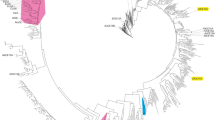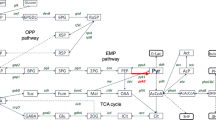Abstract
Ethionine is the toxic S-ethyl analog of the essential amino acid methionine. Whereas in prokaryotes the ethionine just competes with the methionine, in eukaryotes it can also be transformed into S-adenosyl-ethionine (Ado-Eth), competing with the S-adenosyl-methionine (Ado-Met). When the Ado-Met synthetase activity was studied in strains defective in either of the two isoenzymes, the one coded by theSAM1 gene was totally unable to convert ethionine into Ado-Eth and was inhibited by the analog, whereas the enzyme coded by theSAM2 gene was able to bind ethionine and was not inhibited by it. This has allowed the development of a procedure to measure Ado-Met synthetase and differentiate between the two isoenzymes present inSaccharomyces cerevisiae.
Similar content being viewed by others

Literature Cited
Alix J-H (1982) Molecular aspects of the in vivo and in vitro effects of ethionine, an analog of ethionine. Microbiol Rev 46:281–295
Bradford MM (1976) A rapid and sensitive method for the quantitation of microgram quantities of proteins utilizing the principle of protein-dye binding. Anal Biochem 72:248–254
Cherest H, Surdin-Kerjan Y, Antoniewski J, Robichon-Szulmajster H (1973) Effects of regulatory mutations upon methionine biosynthesis inSaccharomyces cerevisiae. J Bacteriol 115:1084–1093
Cherest H, Surdin-Kerjan, Y, Exinger F, Lacronte F (1978) S-adenosylmethionine requiring mutants inSaccharomyces cerevisiae. Mol Gen Genet 163:153–167
Jiménez J, Benítez T (1988) Selection of ethanol-tolerant yeast hybrids in pH-regulated continuous culture. Appl Environ Microbiol 54:917–922
Martínez-Force E, Benítez T (1991) Separation of O-phthalaldehyde derivatives of amino acids of the internal pool of yeast by reverse-phase liquid chromatography. Biotechnol Techn 5:209–214
Martínez-Force E, Benítez T (1992) Selection of amino-acid overproducer yeast mutants. Curr Genet 21:191–196
Martínez-Force E, Benítez T (1992) Changes in yeast amino acid pool with respiratory versus fermentative metabolism. Biotechnol Bioeng 40:643–649
Martínez-Force E, Benítez T (1993) Regulation of aspartatederived amino acid biosynthesis in the yeastSaccharomyces cerevisiae. Curr Microbiol 26:313–322
Mountain HA, Byström AS, Larsen JT, Korch C (1991) Four mayor transcriptional responses in the methionine/threonine biosynthetic pathway ofSaccharomyces cerevisiae. Yeast 7:781–803
Ramos C, Delgado MA, Calderón IL (1991) Inhibition by different amino acids of the aspartate kinase and the homoserine kinase of the yeastSaccharomyces cerevisiae. FEBS Lett 278:123–126
Thomas D, Surdin-Kerjan Y (1991) The synthesis of the two S-adenosyl-methionine synthetases is differently regulated inSaccharomyces cerevisiae. Mol Gen Genet 226:224–232
Thomas D, Rothstein R, Rosenberg N, Surdin-Kerjan Y (1988).SAM2 encodes the second methionine S-adenosyl transferase inSaccharomyces cerevisiae. Mol Cell Biol 8:5132–5139
Author information
Authors and Affiliations
Rights and permissions
About this article
Cite this article
Martínez-Force, E., Benítez, T. TheSAM2 gene product catalyzes the formation of S-adenosyl-ethionine from ethionine inSaccharomyces cerevisiae . Current Microbiology 28, 339–343 (1994). https://doi.org/10.1007/BF01570198
Issue Date:
DOI: https://doi.org/10.1007/BF01570198



